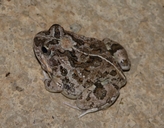|
Tomopterna cryptotis (Boulenger, 1907)
Cryptic Sand Frog, Isele lasesihlabathini elinemigqa (Zulu) | family: Pyxicephalidae subfamily: Cacosterninae genus: Tomopterna |
| Species Description: Boulenger, G. A. (1907). Description of a new frog discovered by Dr. W. J. Ansorge in Mossamedes, Angola. Annals and Magazine of Natural History, Series 7, 20: 109. | |
 © 2015 Andrew Tonge (1 of 20) |
|
|
|
Description Coloration: The brownish to beige basic color is either dark mottled or reticulated. A pale vertebral stripe occurs rather often. Pale dorsolateral lines may be present, too. The infratympanic ridge is white. Numerous dark brown, greenish or reddish spots, rather often with black borders, are distributed over head, back and flanks. A light occipital patch occasionally appears on the head. Dark bar markings are found on the upper lip and on the extremities. The venter is light colored, i.e. cream to white. Both sexes have dark bars on the lower jaws. On males, the throat is black as well. Voice: A short advertisement call with a high frequency is uttered 10–12 times per second (Passmore & Carruthers 1995). Lambiris (1989) describes the advertisement call as a sequence of metallic "chirps" which are repeated very rapidly. Schiøtz (1964c) gives a rapid sequence of low calls lasting 0.3–0.4 sec. DuPreez (1996) describes the advertisement call as a high pitched "KiKiKi". The males call in a chorus and utter approximately 10 calls per second. According to Channing & Bogart (1996), the call characters of T. cryptotis from South Africa are: a call rate of 5–9 calls/sec, with a frequency of 3.1–3.8 kHz, and a note length of 23–48 ms. Passmore (1981a) measured a pressure of 103.5–108 dB at a distance of 50 cm from calling males. Distribution and Habitat Country distribution from AmphibiaWeb's database: Angola, Botswana, Cameroon, Chad, Eritrea, Ethiopia, Kenya, Lesotho, Malawi, Mauritania, Mozambique, Namibia, Niger, Nigeria, Senegal, Somalia, South Africa, South Sudan, Sudan, Swaziland, Tanzania, United Republic of, Uganda, Zambia, Zimbabwe
Range: This species has not yet been recorded at Comoé National Park. In particular, records are available for the following countries: Senegal, Nigeria, Niger, Cameroon, Sudan, Ethiopia, Eritrea, Somalia, Uganda, Kenya, Tanzania, Malawi, Zambia, Zimbabwe, Mozambique, South Africa, Botswana, Namibia, Angola (Boettger 1887, Nieden 1915, Loveridge 1925, 1930, 1933, 1957, Scortecci 1929, Parker 1932, 1936b, Angel 1936, Mertens 1955a, b, 1971, Schiøtz 1963, 1964c, 1967, Poynton 1964a, c, Laurent 1965, Perret 1966, Stewart 1967, Broadley 1971, Böhme 1978, Forge & Barbault 1978, Lanza 1978, 1981, Bowker & Bowker 1979, Poynton & Broadley 1985b, Wager 1986, Branch 1988, Lambiris 1988, 1989, Channing 1989, Rödel 1990, Channing & Griffin 1993, Poynton & Haake 1993, Simbotwe & Mubemba 1993, Bates 1995, Passmore & Carruthers 1995, DuPreez 1996, Salvador 1996, Kok et al. 1997, Largen 1997a, 1998). The extreme south-eastern and south-western parts of South Africa remain beyond the range of this species (Passmore & Carruthers 1995). Life History, Abundance, Activity, and Special Behaviors Spawn: 2000–3000 pigmented eggs (egg diameter: 1.5 mm, with jelly 3 mm) are deposited individually in shallow, usually rather turbid water. The tadpoles hatch 2–3 days later (Wager 1986, Lambiris 1989, Passmore & Carruthers 1995). Smit (1992) got 966 eggs from a pair. Larva The tadpoles are usually very indolent, lying motionless at the bottom. They form swarms when the waters are in danger of drying up so that more food is whirled up, and thus becomes available (Burton 1972, Lambiris 1989). Comments
References
Phaka, F.M., Netherlands, E.C., Kruger, D.J.D., Du Preez, L.H. (2019). Folk taxonomy and indigenous names for frogs in Zululand, South Africa. J Ethnobiology Ethnomedicine 15, 17. [link] Rödel, M. O. (2000). Herpetofauna of West Africa, Vol. I. Amphibians of the West African Savanna. Edition Chimaira, Frankfurt, Germany. Originally submitted by: Marc-Oliver Rödel (first posted 2001-05-02) Edited by: Vance T. Vredenburg, Michelle S. Koo (2024-02-25) Species Account Citation: AmphibiaWeb 2024 Tomopterna cryptotis: Cryptic Sand Frog <https://amphibiaweb.org/species/5198> University of California, Berkeley, CA, USA. Accessed Jun 11, 2025.
Feedback or comments about this page.
Citation: AmphibiaWeb. 2025. <https://amphibiaweb.org> University of California, Berkeley, CA, USA. Accessed 11 Jun 2025. AmphibiaWeb's policy on data use. |



 Map of Life
Map of Life